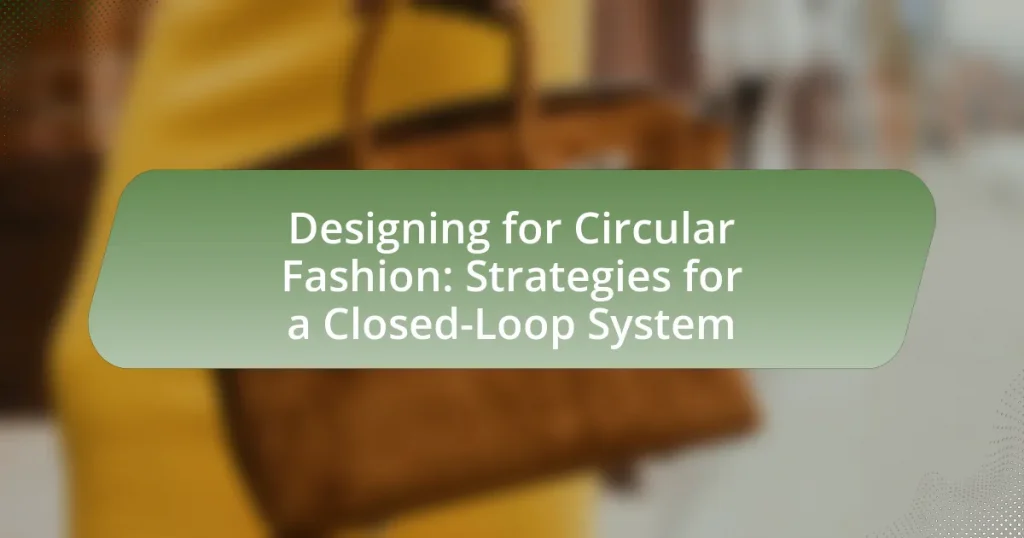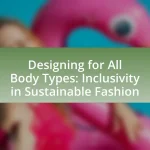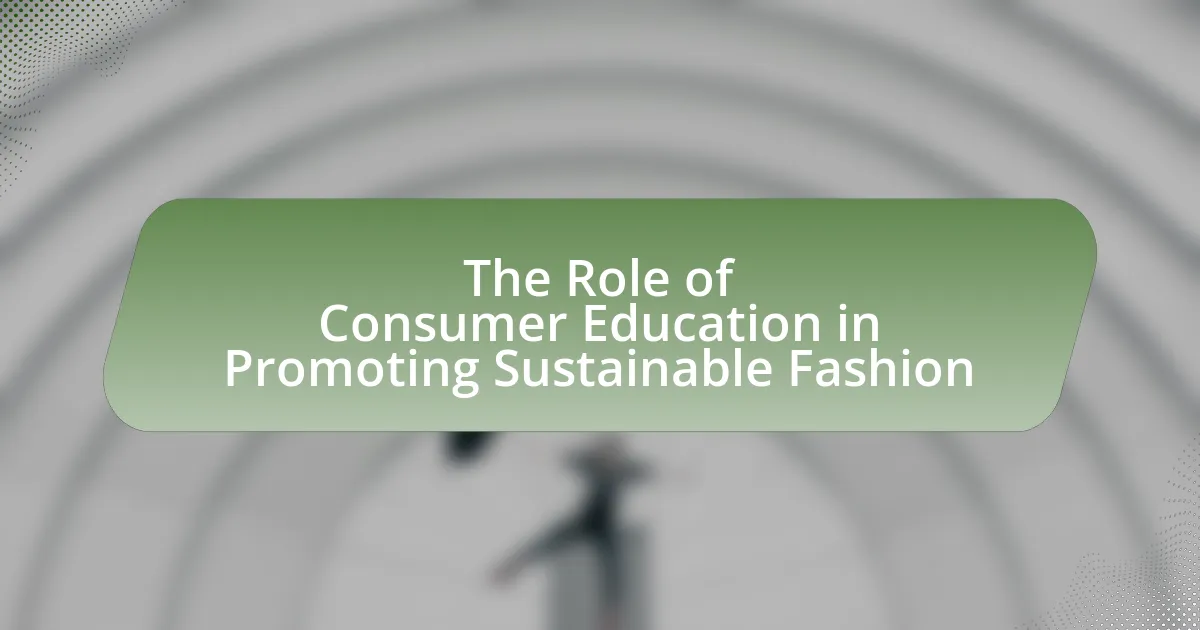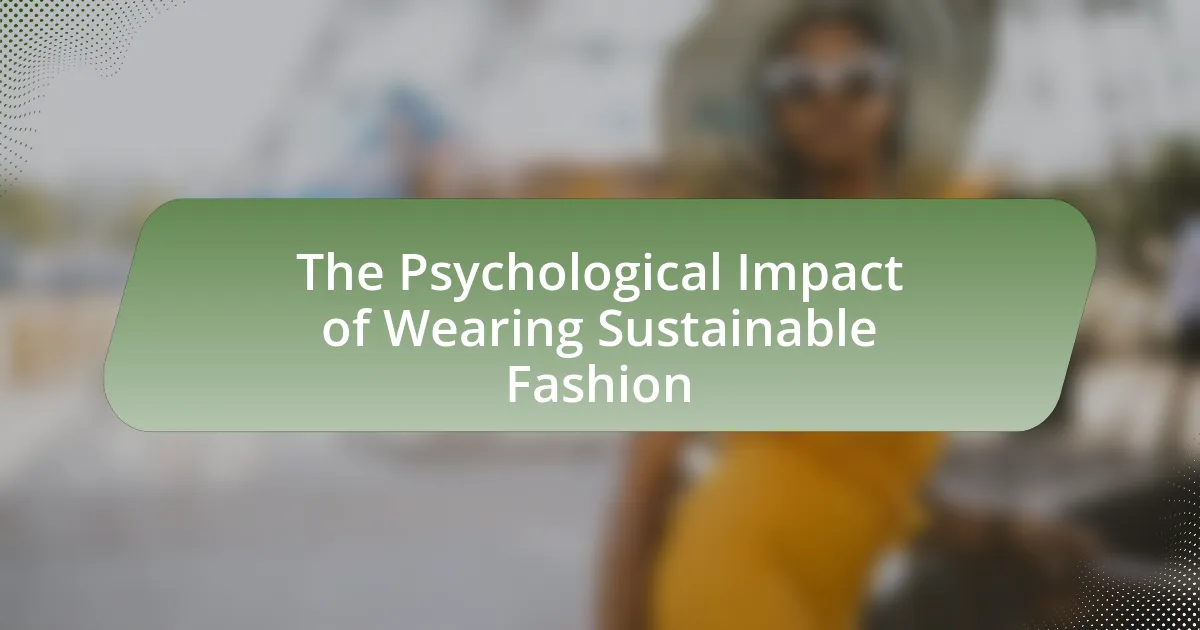Circular fashion is a sustainable approach to clothing design that prioritizes the reuse, recycling, and regeneration of materials to minimize waste and environmental impact. This article explores the differences between circular and traditional fashion, highlighting the key principles of sustainability, resource efficiency, and product longevity. It addresses the challenges facing circular fashion, including consumer awareness and recycling infrastructure, while emphasizing the role of technology and collaboration among stakeholders in promoting a closed-loop system. Additionally, it outlines practical strategies for brands and individuals to support circular fashion, showcasing successful case studies and best practices for recycling and upcycling clothing.
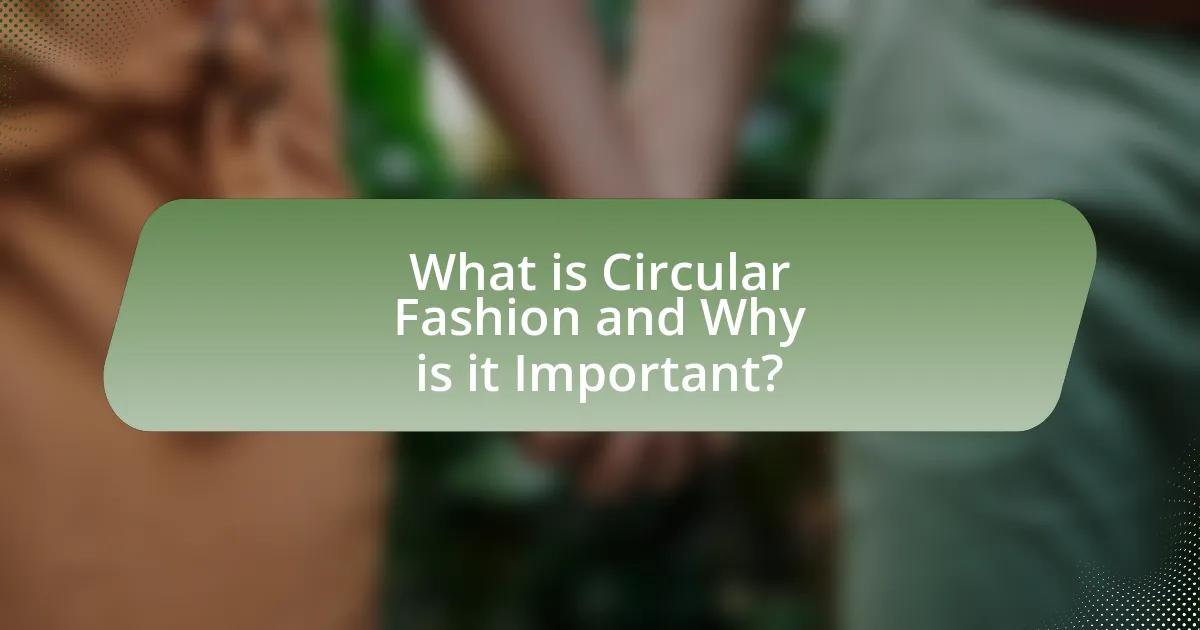
What is Circular Fashion and Why is it Important?
Circular fashion is a sustainable approach to clothing design and production that emphasizes the reuse, recycling, and regeneration of materials to minimize waste and environmental impact. This model is important because it addresses the significant issues of textile waste, which accounts for approximately 92 million tons annually, and promotes a more sustainable lifecycle for fashion products. By shifting from a linear “take-make-dispose” model to a circular system, circular fashion not only reduces resource consumption but also fosters innovation in material use and encourages responsible consumer behavior, ultimately contributing to a more sustainable economy.
How does Circular Fashion differ from Traditional Fashion?
Circular Fashion focuses on sustainability and resource efficiency by designing products for longevity, reuse, and recycling, while Traditional Fashion typically emphasizes fast production and consumption, leading to significant waste. In Circular Fashion, materials are chosen for their ability to be repurposed or recycled, reducing environmental impact, whereas Traditional Fashion often relies on single-use materials that contribute to landfill overflow. According to the Ellen MacArthur Foundation, the fashion industry is responsible for 92 million tons of waste annually, highlighting the inefficiencies of Traditional Fashion compared to the resource-conscious approach of Circular Fashion.
What are the key principles of Circular Fashion?
The key principles of Circular Fashion include designing for longevity, promoting resource efficiency, and encouraging recycling and upcycling. Designing for longevity ensures that garments are made to last, reducing the frequency of disposal. Resource efficiency focuses on minimizing waste and utilizing sustainable materials throughout the production process. Recycling and upcycling emphasize the importance of reusing materials and transforming old garments into new products, thereby closing the loop in the fashion lifecycle. These principles collectively aim to reduce environmental impact and promote sustainable practices within the fashion industry.
Why is sustainability a core aspect of Circular Fashion?
Sustainability is a core aspect of Circular Fashion because it aims to minimize waste and resource consumption throughout the lifecycle of fashion products. Circular Fashion promotes the reuse, recycling, and upcycling of materials, which reduces the environmental impact associated with traditional linear fashion models that often lead to significant waste and pollution. For instance, the Ellen MacArthur Foundation reports that the fashion industry is responsible for 10% of global carbon emissions and significant water usage, highlighting the urgent need for sustainable practices. By integrating sustainability into its framework, Circular Fashion not only addresses these environmental challenges but also fosters a more responsible and ethical approach to production and consumption in the fashion industry.
What are the challenges facing Circular Fashion?
Circular fashion faces several challenges, including limited consumer awareness, inadequate recycling infrastructure, and the complexity of supply chains. Limited consumer awareness hinders the adoption of circular practices, as many individuals remain uninformed about the benefits and principles of circular fashion. Inadequate recycling infrastructure complicates the process of reclaiming materials, with only 1% of clothing being recycled into new garments, according to the Ellen MacArthur Foundation. Additionally, the complexity of supply chains makes it difficult for brands to track materials and ensure that products are designed for longevity and recyclability, leading to increased waste and resource depletion.
How do consumer behaviors impact Circular Fashion initiatives?
Consumer behaviors significantly impact Circular Fashion initiatives by driving demand for sustainable practices and influencing brand strategies. When consumers prioritize eco-friendly products, brands are compelled to adopt circular practices such as recycling, upcycling, and sustainable sourcing to meet these expectations. Research indicates that 66% of global consumers are willing to pay more for sustainable brands, highlighting the economic incentive for companies to embrace circularity. Additionally, consumer engagement in recycling and second-hand markets fosters a culture of reuse, further promoting circular fashion principles.
What role do regulations play in promoting Circular Fashion?
Regulations play a crucial role in promoting Circular Fashion by establishing legal frameworks that encourage sustainable practices within the fashion industry. These regulations often mandate waste reduction, resource efficiency, and the use of recyclable materials, thereby incentivizing brands to adopt circular business models. For instance, the European Union’s Circular Economy Action Plan aims to make sustainable products the norm, which includes specific directives for textiles to enhance recyclability and reduce environmental impact. Such regulatory measures not only drive compliance but also foster innovation in sustainable design and production processes, ultimately contributing to a more circular economy in fashion.
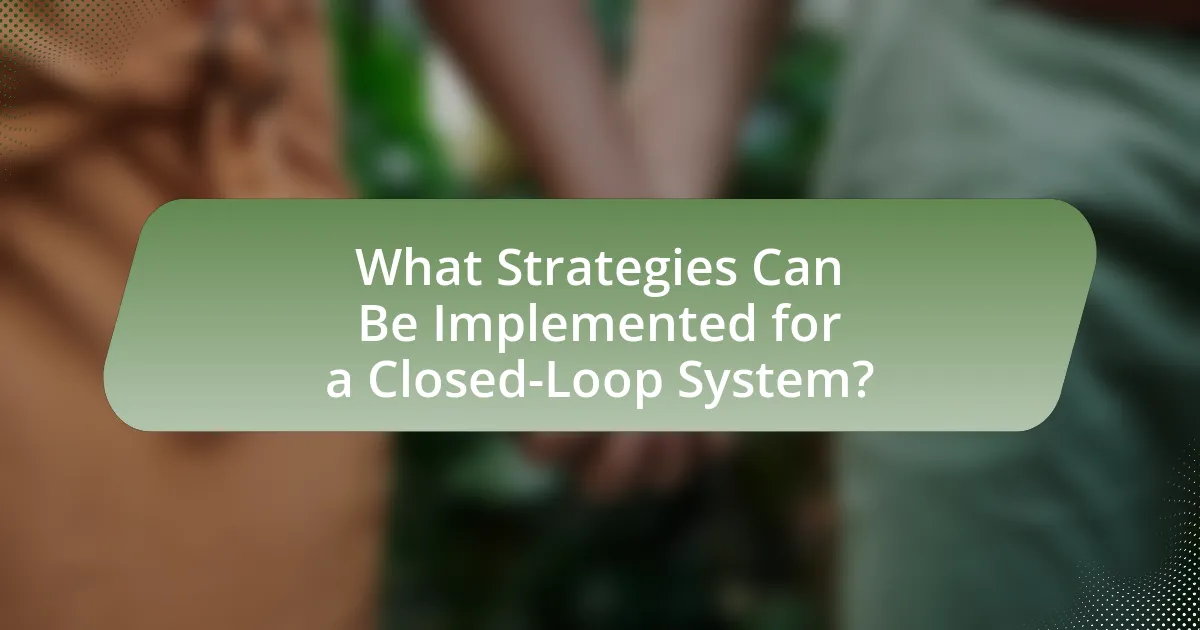
What Strategies Can Be Implemented for a Closed-Loop System?
Strategies that can be implemented for a closed-loop system in circular fashion include designing for durability, utilizing recyclable materials, and establishing take-back programs. Designing for durability ensures products have a longer lifespan, reducing waste; for example, companies like Patagonia create high-quality outdoor gear that lasts. Utilizing recyclable materials allows for easier processing at the end of a product’s life, as seen in brands like Adidas, which incorporates recycled ocean plastic into their footwear. Establishing take-back programs encourages consumers to return products for recycling or repurposing, exemplified by H&M’s garment collection initiative, which promotes recycling and reduces landfill waste. These strategies collectively contribute to a more sustainable and efficient closed-loop system.
How can brands design products for longevity?
Brands can design products for longevity by utilizing durable materials, implementing modular designs, and ensuring ease of repair. Durable materials, such as high-quality textiles and metals, enhance product lifespan, as evidenced by studies showing that products made from robust materials can last significantly longer than those made from cheaper alternatives. Modular designs allow for easy upgrades and replacements of parts, which encourages consumers to maintain rather than discard products. Additionally, ensuring ease of repair can be supported by providing clear instructions and necessary tools, which has been shown to increase the likelihood of product longevity. These strategies collectively contribute to a more sustainable approach in the context of circular fashion, promoting a closed-loop system where products are designed to last and be reused.
What materials are best suited for Circular Fashion?
The materials best suited for Circular Fashion include organic cotton, Tencel, recycled polyester, and hemp. Organic cotton is favored for its biodegradability and reduced environmental impact compared to conventional cotton. Tencel, made from sustainably sourced wood pulp, is known for its closed-loop production process that minimizes waste. Recycled polyester, derived from post-consumer plastic bottles, helps reduce landfill waste and conserves resources. Hemp is a durable, fast-growing crop that requires minimal water and pesticides, making it an eco-friendly option. These materials align with the principles of Circular Fashion by promoting sustainability and reducing environmental harm.
How can modular design enhance product lifecycle?
Modular design enhances product lifecycle by allowing for easier upgrades, repairs, and recycling of components. This approach enables manufacturers to replace or update specific parts without discarding the entire product, thereby extending its usability and reducing waste. For instance, a study by the Ellen MacArthur Foundation highlights that modular products can lead to a 20-30% reduction in resource consumption and waste generation, supporting a more sustainable circular economy. By facilitating disassembly and reconfiguration, modular design not only improves product longevity but also aligns with the principles of circular fashion, promoting a closed-loop system.
What role does technology play in Circular Fashion?
Technology plays a crucial role in Circular Fashion by enabling efficient resource management and waste reduction throughout the product lifecycle. Advanced technologies such as blockchain facilitate transparency in supply chains, allowing brands to track materials and ensure sustainable sourcing. Additionally, innovations like 3D printing and digital design reduce material waste by enabling on-demand production, while recycling technologies improve the recovery of materials from discarded garments. According to a report by the Ellen MacArthur Foundation, implementing these technologies can significantly decrease the environmental impact of the fashion industry, highlighting their importance in promoting a circular economy.
How can digital tools facilitate recycling and upcycling?
Digital tools facilitate recycling and upcycling by providing platforms for information sharing, tracking materials, and connecting consumers with recycling services. For instance, mobile applications can help users identify recyclable materials and locate nearby recycling centers, enhancing participation in recycling programs. Additionally, digital design software enables creators to visualize and plan upcycling projects, making it easier to repurpose materials effectively. Research indicates that the use of digital platforms can increase recycling rates by up to 30%, as they streamline the process and raise awareness about sustainable practices.
What innovations are driving Circular Fashion forward?
Innovations driving Circular Fashion forward include advanced recycling technologies, sustainable materials, and digital platforms for resale and rental. Advanced recycling technologies, such as chemical recycling, enable the breakdown of textiles into their original fibers, allowing for the creation of new garments from old ones. Sustainable materials, like bio-based fabrics and recycled fibers, reduce the environmental impact of production. Digital platforms facilitate the resale and rental of clothing, promoting a circular economy by extending the lifecycle of garments. These innovations collectively contribute to reducing waste and resource consumption in the fashion industry.
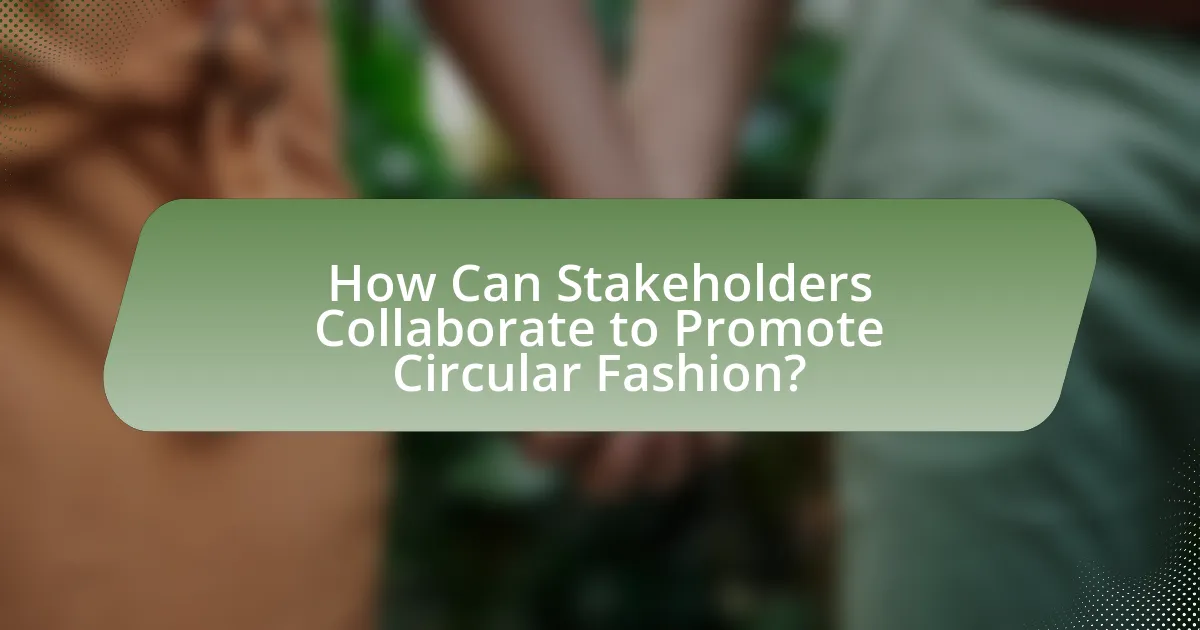
How Can Stakeholders Collaborate to Promote Circular Fashion?
Stakeholders can collaborate to promote circular fashion by establishing partnerships that facilitate resource sharing, innovation, and consumer engagement. For instance, brands can work with manufacturers to design products that are easier to recycle, while retailers can implement take-back programs that encourage consumers to return used items. Research from the Ellen MacArthur Foundation highlights that collaboration across the supply chain can reduce waste by up to 80% when circular practices are adopted. Additionally, stakeholders can engage in joint marketing campaigns that educate consumers about the benefits of circular fashion, thereby increasing demand for sustainable products.
What partnerships are essential for a successful Circular Fashion ecosystem?
Essential partnerships for a successful Circular Fashion ecosystem include collaborations between fashion brands, recycling companies, technology providers, and consumers. Fashion brands must work with recycling companies to ensure that materials are effectively reclaimed and reused, which is critical for closing the loop in fashion. Technology providers play a vital role by offering innovative solutions for tracking materials and enhancing supply chain transparency, enabling brands to make informed decisions about sustainability. Additionally, engaging consumers in the circular economy through education and incentives fosters responsible consumption and encourages participation in recycling initiatives. These partnerships collectively drive the transition towards a sustainable, closed-loop system in the fashion industry.
How can brands collaborate with consumers for better recycling practices?
Brands can collaborate with consumers for better recycling practices by implementing educational campaigns that inform consumers about proper recycling methods and the environmental impact of their choices. For instance, brands can provide clear labeling on products that indicates how to recycle them effectively, which has been shown to increase recycling rates by up to 30% according to a study by the Ellen MacArthur Foundation. Additionally, brands can engage consumers through take-back programs, where consumers return used products for recycling, thereby fostering a sense of responsibility and participation in the recycling process. This approach not only enhances consumer awareness but also contributes to a circular economy by ensuring materials are reused and repurposed.
What role do NGOs and governments play in supporting Circular Fashion?
NGOs and governments play crucial roles in supporting Circular Fashion by implementing policies, promoting sustainable practices, and facilitating collaboration among stakeholders. Governments establish regulations that encourage waste reduction and resource efficiency, such as extended producer responsibility laws, which hold manufacturers accountable for the lifecycle of their products. NGOs often advocate for sustainable practices, raise awareness about the environmental impact of fashion, and provide resources for brands to adopt circular strategies. For instance, the Ellen MacArthur Foundation collaborates with various organizations to promote circular economy principles in the fashion industry, demonstrating the effectiveness of partnerships in driving systemic change.
What are some successful case studies in Circular Fashion?
Successful case studies in Circular Fashion include the initiatives by brands like Patagonia, which promotes repair and reuse through its Worn Wear program, allowing customers to trade in used gear for store credit. Another example is the Dutch company Mud Jeans, which offers a leasing model for denim, encouraging customers to return their jeans for recycling. Additionally, the fashion brand Eileen Fisher has implemented a take-back program that recycles old garments into new products, demonstrating a commitment to sustainability. These case studies illustrate effective strategies for reducing waste and promoting a closed-loop system in the fashion industry.
Which brands have effectively implemented Circular Fashion strategies?
Patagonia, Eileen Fisher, and Nike are brands that have effectively implemented Circular Fashion strategies. Patagonia has pioneered the use of recycled materials and offers a repair program to extend the life of its products. Eileen Fisher focuses on take-back programs and recycling initiatives, aiming to create a closed-loop system for its garments. Nike has introduced the “Move to Zero” initiative, which emphasizes sustainable materials and recycling through its “Reuse-A-Shoe” program. These brands demonstrate a commitment to reducing waste and promoting sustainability in the fashion industry.
What lessons can be learned from these case studies?
Lessons learned from case studies on designing for circular fashion include the importance of integrating sustainability into product design, emphasizing the need for collaboration across the supply chain, and recognizing consumer behavior’s role in promoting circular practices. For instance, successful case studies demonstrate that products designed with recyclable materials significantly reduce waste, as seen in brands that utilize post-consumer textiles. Additionally, collaboration among manufacturers, retailers, and consumers fosters innovation and efficiency, leading to more effective closed-loop systems. Lastly, understanding consumer preferences for sustainable products can drive demand and encourage brands to adopt circular strategies, as evidenced by increased sales in companies that prioritize eco-friendly practices.
What practical steps can individuals take to support Circular Fashion?
Individuals can support Circular Fashion by adopting sustainable practices such as buying second-hand clothing, choosing brands that prioritize sustainability, and recycling or upcycling garments. Buying second-hand reduces demand for new production, which is a significant contributor to environmental degradation. Supporting brands that utilize sustainable materials and ethical labor practices encourages a shift in the industry towards more responsible production methods. Additionally, recycling or upcycling clothing extends the life cycle of garments, minimizing waste and promoting resource efficiency. According to the Ellen MacArthur Foundation, the fashion industry could reduce its greenhouse gas emissions by 44% by 2030 through such circular practices.
How can consumers make more sustainable fashion choices?
Consumers can make more sustainable fashion choices by prioritizing brands that utilize eco-friendly materials and ethical production practices. Research indicates that the fashion industry is responsible for 10% of global carbon emissions, highlighting the importance of selecting brands that minimize their environmental impact. Additionally, consumers can opt for second-hand clothing, which reduces waste and extends the lifecycle of garments. According to a study by the Ellen MacArthur Foundation, extending the life of clothes by just nine months can reduce carbon, water, and waste footprints by 20-30%. Furthermore, supporting local artisans and sustainable brands fosters a circular economy, encouraging practices that promote recycling and upcycling.
What are the best practices for recycling and upcycling clothing?
The best practices for recycling and upcycling clothing include sorting textiles by material type, cleaning garments before recycling, and donating or selling items that are still wearable. Sorting textiles ensures that materials are processed correctly; for instance, cotton can be recycled into new cotton products, while polyester can be repurposed into insulation or other products. Cleaning garments removes contaminants that can hinder the recycling process, as dirty textiles may be rejected by recycling facilities. Additionally, donating or selling wearable clothing extends the life cycle of the garment, reducing waste and promoting a circular economy. According to the Ellen MacArthur Foundation, extending the life of clothing by just nine months can reduce carbon, water, and waste footprints by around 20-30%.
